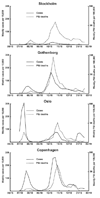Epidemiologic characterization of the 1918 influenza pandemic summer wave in Copenhagen: implications for pandemic control strategies
- PMID: 18194088
- PMCID: PMC2674012
- DOI: 10.1086/524065
Epidemiologic characterization of the 1918 influenza pandemic summer wave in Copenhagen: implications for pandemic control strategies
Abstract
Background: The 1918-1919 A/H1N1 influenza pandemic killed approximately 50 million people worldwide. Historical records suggest that an early pandemic wave struck Europe during the summer of 1918.
Methods: We obtained surveillance data that were compiled weekly, during 1910-1919, in Copenhagen, Denmark; the records included medically treated influenza-like illnesses (ILIs), hospitalizations, and deaths by age. We used a Serfling seasonal regression model to quantify excess morbidity and mortality, and we estimated the reproductive number (R) for the summer, fall, and winter pandemic waves.
Results: A large epidemic occurred in Copenhagen during the summer of 1918; the age distribution of deaths was characteristic of the 1918-1919 A/H1N1 pandemic overall. That summer wave accounted for 29%-34% of all excess ILIs and hospitalizations during 1918, whereas the case-fatality rate (0.3%) was many-fold lower than that of the fall wave (2.3%). Similar patterns were observed in 3 other Scandinavian cities. R was substantially higher in summer (2.0-5.4) than in fall (1.2-1.6) in all cities.
Conclusions: The Copenhagen summer wave may have been caused by a precursor A/H1N1 pandemic virus that transmitted efficiently but lacked extreme virulence. The R measured in the summer wave is likely a better approximation of transmissibility in a fully susceptible population and is substantially higher than that found in previous US studies. The summer wave may have provided partial protection against the lethal fall wave.
Conflict of interest statement
Potential conflicts of interest: none reported.
Figures



Comment in
-
Influenza pandemics, immune cross-reactivity, and pandemic control strategies.J Infect Dis. 2008 Jul 15;198(2):294-5; author reply 295-6. doi: 10.1086/589302. J Infect Dis. 2008. PMID: 18593297 No abstract available.
References
-
- Ferguson NM, Cummings DA, Cauchemez S, et al. Strategies for containing an emerging influenza pandemic in Southeast Asia. Nature. 2005;437:209–214. - PubMed

